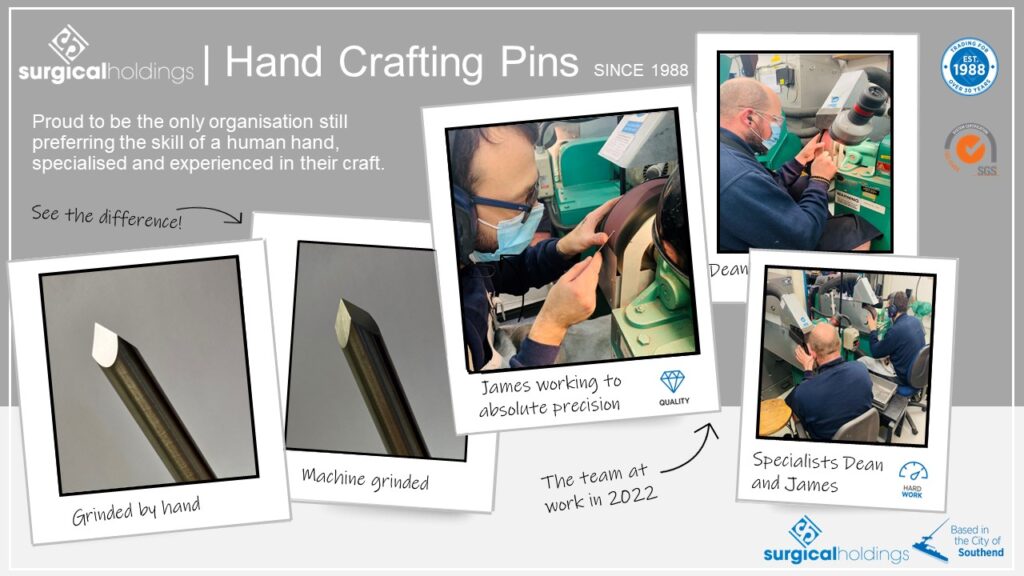
Pinpointing the Pinnacle Moment
You may be wondering, what could be the profound significance of these relatively small and supposedly simple devices, in a story that gives an entire family business leverage into what would become over three decades of business, growth and success.
Well, it’s a simple as this. Chairman Phillip Coole started the whole venture with an order of tens of thousands of bone pins from then “HowMedica”.
Before Phil established himself as Managing Director for his own family run business, the journey spring boarded from having first worked as an apprentice, taking on an order that was far more than what it seemed.
It was an order of opportunity to help a large company keep on top of the demand, sourcing the orthopaedic wires externally. It was Phil and Terry, young and prosperous back in the day who stepped up and took on the order, grinding this vast quantity of pins by hand… in their first workshop in the happiest place in the UK, Leigh-on-Sea!
Let’s take a moment to revise what are orthopaedic wires and all the questions that follow.
Education | Understanding Orthopaedic Wires
Firstly, what are bone pins & wires?
Bone pins and wires are from the osteosyntheses implant family. Osteosynthesis is the fixation of bone. There are a range of bone pins and wires, all manufactured by us here at Surgical Holdings. Variations include Kirschner Wires, Arthrodesis Wires, Steinmann and Denham Threaded Pins in both Sterile and non sterile.
These devices are a form of implant, so they are made from high graded 316 LVM stainless steel, as per ISO 5832-1. They are drilled into the bone to stabilise bone fragments following a break or fracture and they are normally in place for around 120 days.
What are they used for?
Bone pins are used for internal fixation during orthopaedic surgery. They are drilled into the bone to secure fragmented bone into place.
They can only to be implanted by a qualified medical practitioner using compatible CE marked instruments/Devices.
What are the variations of bone pins?
Kirschner Wires provide an anchor for skeletal traction. K-irschner wires can also be used to guide cannulated screws to a precise location and for temporary joint immobilisation. The wires are used for temporary fixation during some operations. After definitive fixation, the wires are then removed.
Skeletal/Arthrodesis wires as an exception should only be used for fusion, skeletal traction, and fixation (to fixate bones while they are healing) in the areas of the body for which they were intended, namely hands and feet. They are often used to hold together pieces of bone that are too small to be fixed with pins. They are usually removed after a certain amount of time, but they may be left in permanently for some fractures.
How long do they last?
Bone pins and skeletal wires are implanted at the discretion of the medical practitioner. For non-permanent implants such as K-Wires, they should be removed after 120 days, and are never for re-usage.
All Implants are manufactured as per the relevant international standard for material. To recap, they are made from High grade 316 LVM stainless steel as to ensure that they never deteriorate inside the body.
Why are we so excited about producing these pins?
When we ask our Chairman Phil, what is it about these pins that are so special, he claims the answer is blatant;
“We are the only people still grinding these pins by hand. It’s our dedicated team made up of very skilled people doing this very specialised process”.
We receive feedback on numerous occasions that support our reasoning for still doing it this way and not following suit to the world of automated machine. Surgeons have been known to prefer our hand grinded pins as we can achieve a bowed effect up to the tip, making it a much more precise and prominent peak.
Exploring the workshop, it is clear to see we have 6 people working on pins every single day, manufacturing around 8 thousand a week.
Once again, we are proud of this demonstration of skillset and experience from our team; the attribute that makes Surgical Holdings different.







